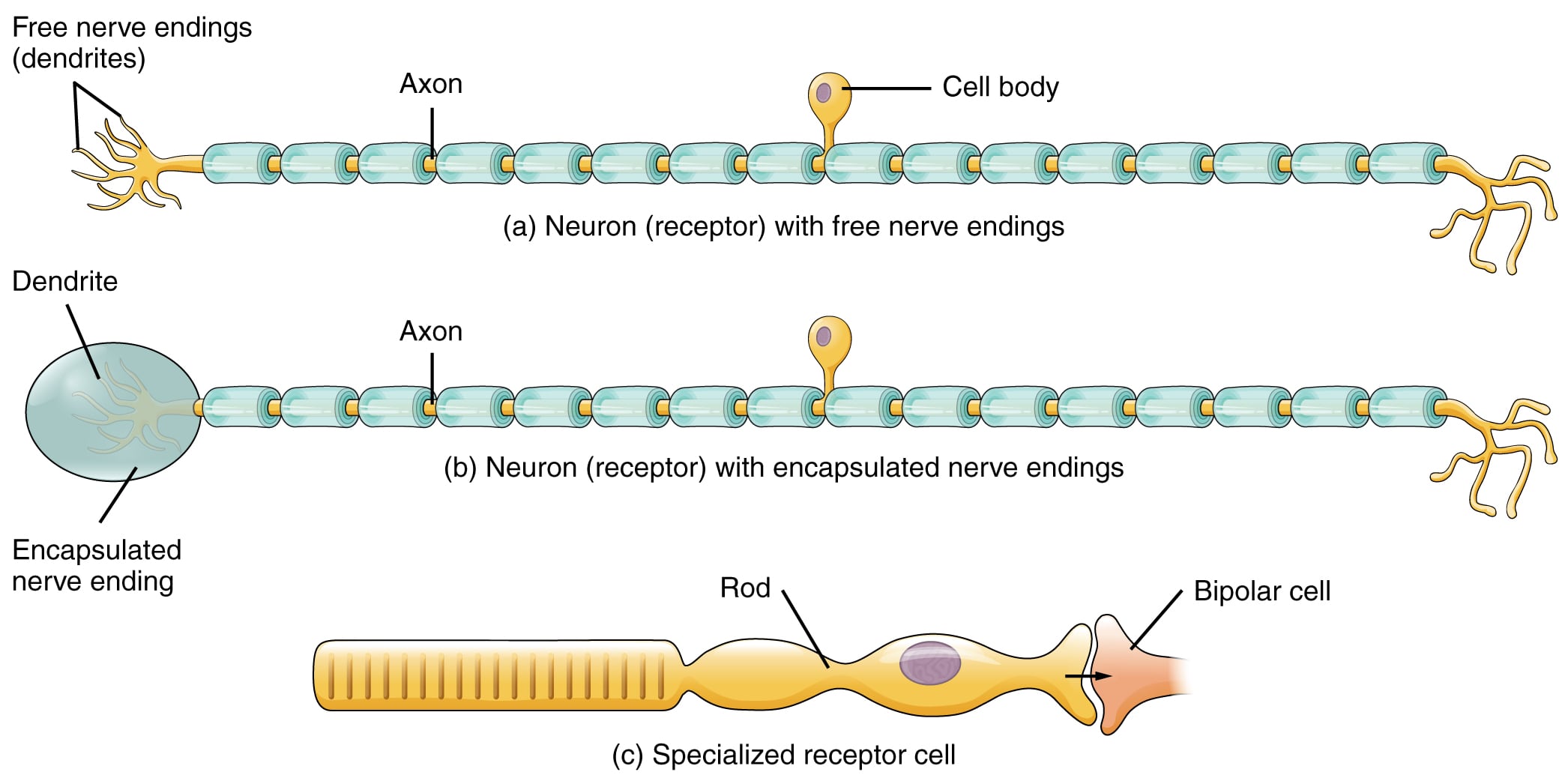Depending on what type of stimulus activates a receptor, sensory receptors can be classified as follows:
Electromagnetic receptors - photoreceptors, thermoreceptors. Photoreceptors are rods and cones of the retina. Thermoreceptors are slowly adapting receptors. They are of two types - warm and cold. Cold receptors mainly sense temperatures between 25-30 degree C. Warm receptors detect temperature range of 30-45 degree C.
Mechanoreceptors - They are activated by pressure or changes in pressure. Examples are receptors for hearing, touch, balance and osmoreceptors. They can be very rapidly and rapidly adapting or slowly adapting. Very rapidly and rapidly adapting mechanoreceptors detect changes in velocity while slowly adapting receptors detect intensity and duration of the stimulus. Following are the types of mechanoreceptors:

Receptor cell types can be classified on the basis of their structure. Sensory neurons can have either (a) free nerve endings or (b) encapsulated endings. Photoreceptors in the eyes, such as rod cells, are examples of © specialized receptor cells. These cells release neurotransmitters onto a bipolar cell, which then synapses with the optic nerve neurons.
Chemoreceptors - Chemoreceptors detect chemical stimuli. Odorant receptors and gustatory receptors are involved in sensations of smell and taste respectively. Similarly, arterial PO2 receptors in the carotid and aortic bodies and pH sensing receptors in the medulla are also chemoreceptors.
Nociceptors: They respond to noxious stimuli that produce tissue damage like extremes of temperatures, high pressures, chemical damage etc. Nociceptors can be thermal or mechanical or polymodal. Thermal are innervated by A- delta myelinated nerve fibres that respond to mechanical stimuli like sharp pain, high pressure etc. Polymodal receptors are innervated by unmyelinated type C nerve fibres that respond to mechanical, chemical, extreme hot and extreme cold stimuli. Transient receptor potential or TRP ion channels are activated on nociceptors in response to these stimuli. In addition, inflammatory mediators like histamine from mast cells, bradykinin, substance P, prostaglandins etc. directly or indirectly activate the nociceptors causing pain and hyperalgesia. Glutamate, substance P, calcitonin and somatostatin are used as neurotransmitters.
Most receptor molecules are tuned to a single sensory modality but some are polymodal (activated by multiple types of sensory stimuli). Activation of receptor molecules by an adequate stimulus initiates a signal transduction process in the sensory receptor during which the physical or chemical signal is amplified and converted into an electrical signal that depolarizes or hyperpolarizes the cell. Such changes in the membrane potential of the receptor is called the receptor potential. Intensity of the stimulus is encoded by activation of larger number of receptors in response to more intense stimuli, change in firing rates and by activation of different types of receptors like nociceptors. The properties of the stimulus such as strength and duration are then translated into a specific temporal pattern of action potentials. These are then finally sensed by the brain.
When a constant stimulus is applied for a longer period of time then receptors get adapted. This means that the frequency of action potentials decreases even though the stimulus is present. Phasic receptors adapt rapidly while tonic receptors adapt slowly.
Types of nerve fibres: There are two different classification systems for nerve fibres, Lloyd -Hunt and Erlanger-Gasser. Generally, myelinated nerves and larger fibres conduct faster than unmyelinated and small diameter fibres. The table below lists nerve fibres in descending order of conduction velocity and diameter.
| Lloyd-Hunt type | Erlanger-Gasser type | Myelination | Sensory receptors innervated |
| Ia | A alpha | Yes | Muscle spindles, alpha motor neurons |
| Ib | A alpha | Yes | Golgi tendon organs, alpha motor neurons |
| II | A beta | Yes | Muscle spindles, mechanoreceptors of skin for touch, pressure. |
| - | A gamma | Yes | Efferents from gamma motor neurons to muscle spindles |
| III | A delta | Yes | Free nerve endings for touch and pressure, nociceptors, cold thermoreceptors, fast pain |
| IV | C | No | Nociceptors, slow pain, warm thermoreceptors, olfaction |
Please refer to CNS anatomy for details on cerebral cortex and cerebellum structure and organization.
Sign up for free to take 12 quiz questions on this topic